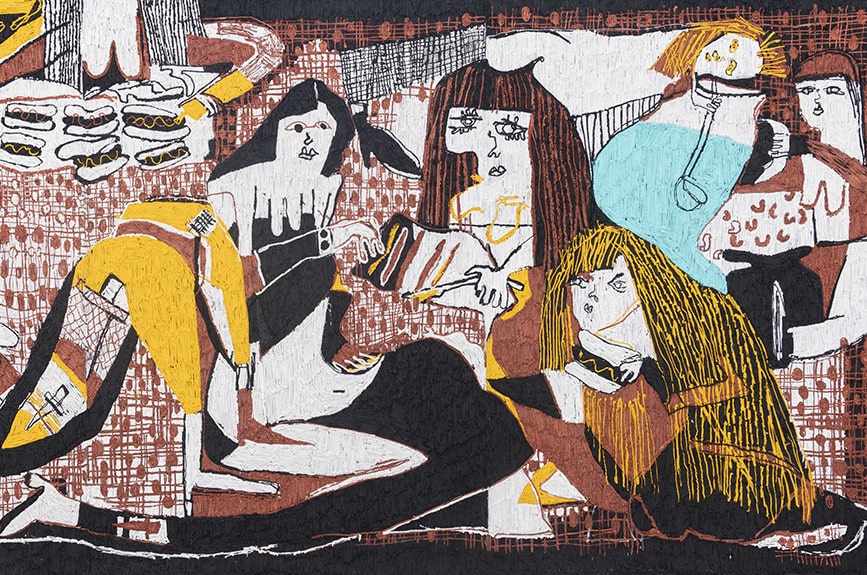Jedes Jahr veranstaltet die Frieze eine internationale Kunstmesse im Randall's Island Park. Obwohl der Schwerpunkt auf den Top-Galerien und Künstlern liegt, gibt es in der Frame-Sektion der Messe, die aufstrebenden Künstlern gewidmet ist, immer noch Platz, um neue Talente zu entdecken.
Die große Bandbreite an Altersgruppen, Karrierestufen und Hintergründen auf der Frieze macht die Ausstellung zu einem faszinierenden Erlebnis. Besonders beeindruckt hat mich die generationsübergreifende Vielfalt, die die Nuancen der einzelnen Werke hervorhebt. Wenn sich die Werke zeitlich und stilistisch überschneiden, werden verschiedene Eigenschaften hervorgehoben und akzentuiert.
Die Stände auf der Frieze, die am meisten in Erinnerung geblieben sind, sind eine Kombination aus jungen Künstlern und etablierten Namen, eine Mischung aus Skulptur, Malerei, Fotografie und mehr. Als eines der wichtigsten Kunstevents in New York gibt es auf der Frieze immer viele Talente zu sehen, aber diese Stände haben uns auch nach der Messe noch zum Nachdenken angeregt.
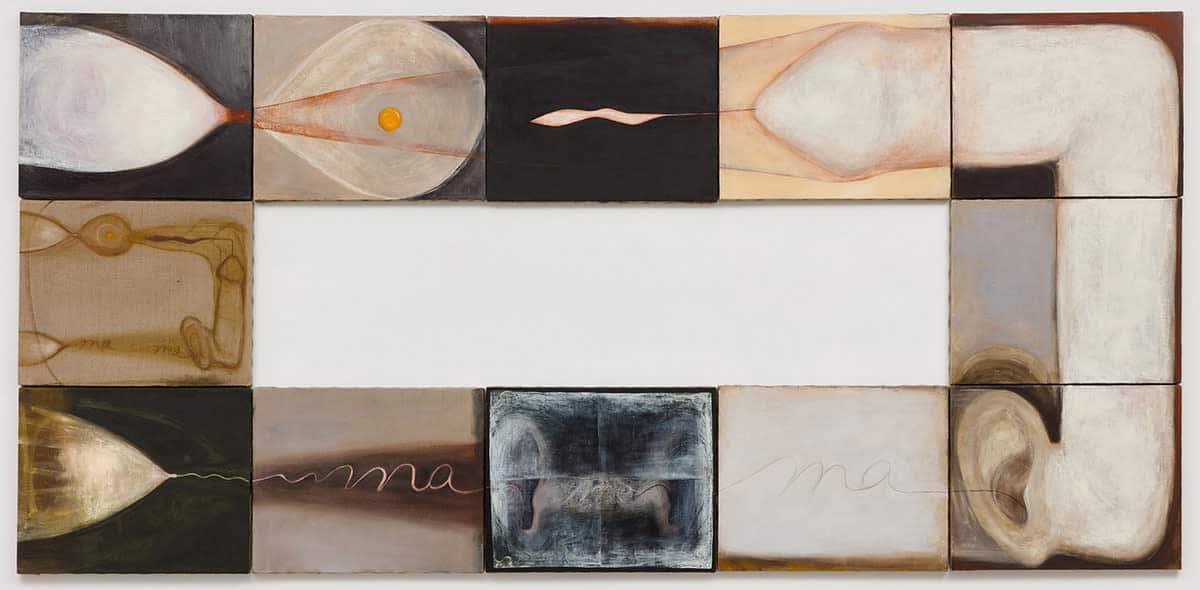
Mira Schor, MA (ich) MA , 1991. 48 x 100 cm. Öl auf 12 Leinwänden. Mit freundlicher Genehmigung von Lyles and King.
Mira Schor bei Lyles und König
Die Werke, die am Stand von Lyles und King auf der Frieze zu sehen waren, sahen zwar zeitgenössisch aus, stammten aber tatsächlich aus den 1990er Jahren und waren vorher noch nie ausgestellt worden. Warum das so ist? Ich habe keine Ahnung, denn sie sind einfach umwerfend. Mira Schor's Die Werke sind kühn, aber sanft, politisch engagiert, aber poetisch, und malerisch ausgeführt, aber mit der Sensibilität von Zeichnungen. Schors Arbeiten ließen mich an die jüngsten Judith Bernstein Show das in der Paul Kasmin Galerie stattfand. Der Raum war voll mit Bildern von Penissen, Day-Glo-Farbe und Schwarzlicht, das Darstellungen von Trump und Mau beleuchtete. Ich dachte, ich sei vielleicht prüde, weil ich diese Werke nicht mochte. Aber Schor hat mich eines Besseren belehrt; ich schätze komplexere Darstellungen. In Schors Werken gibt es Schönheit und Gewalt, und ja, es gibt Phallusse, aber auch viel mehr.
In Schors Fries-Arbeiten sehen wir Gebärmutterformen, die sich über Spermienformen legen, lautmalerische, kursive Wörter und das sich wiederholende Motiv von Phallusköpfen, die in kompositorische, schematische Geometrien eingebunden sind. Ich schätze den Kontrast zwischen dem kontrollierten und grafischen Raum und den lockeren, poetischen Unterbrechungen von Form und Sprache.
Schor schafft in ihrer Arbeit Raum zum Nachdenken und nicht für kämpferische Argumente. Sie vertritt definitiv eine Position, aber sie ist anregend und nicht dogmatisch. Die Bilder schaffen einen ästhetischen und symbolischen Raum, der zum Nachdenken anregt. Ich liebe die verletzende Schönheit dieser pastellfarbenen, erdigen, gemalten Bilder. Die Vielfalt der Strategien und die offenen Interpretationen ermöglichen es, einen ehrlichen Dialog über Sex und Gender zu führen.
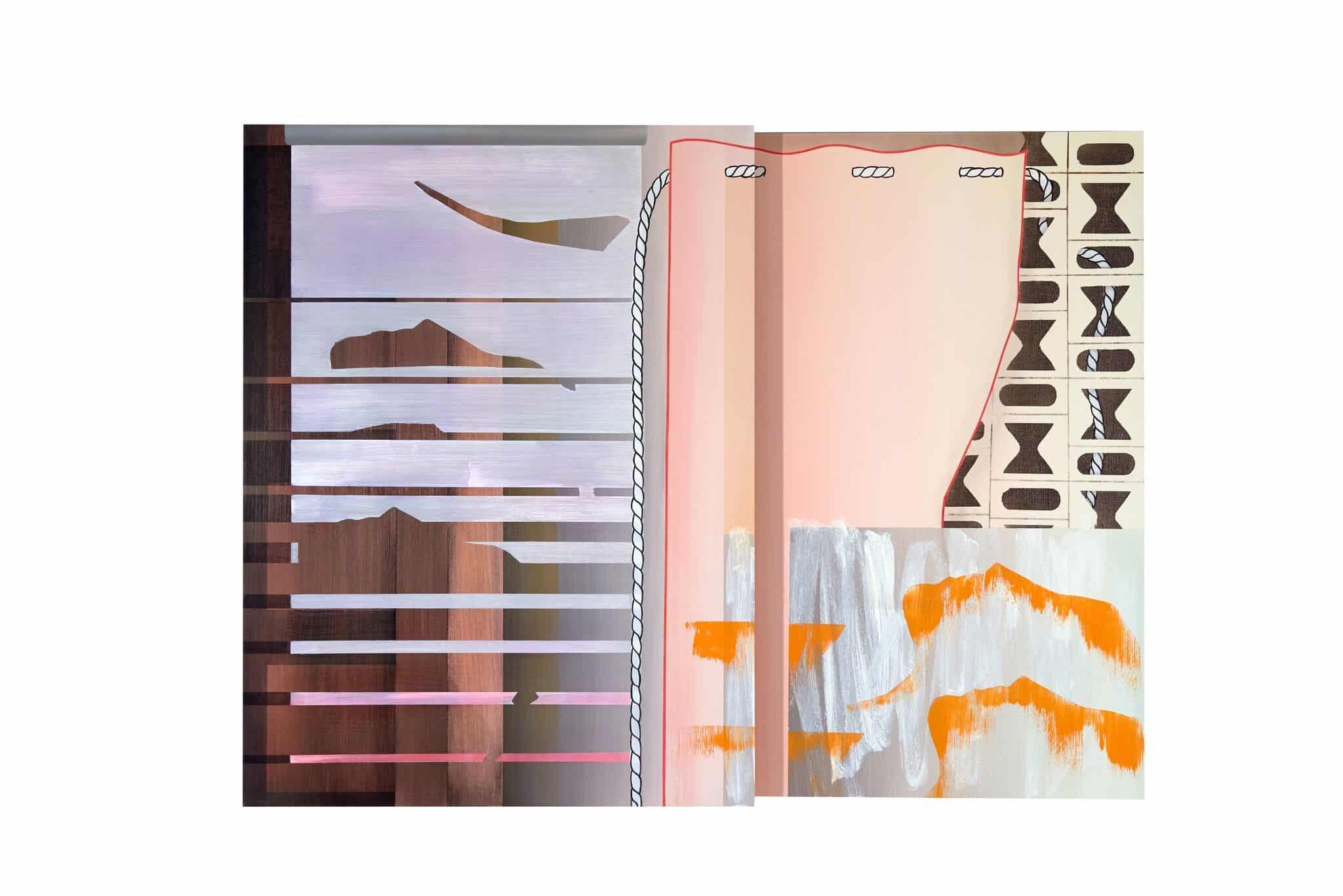
Sonia Almeida. Mit freundlicher Genehmigung der Künstlerin.
Jesse Wine und Sonia Almeida bei Simone Subal Galerie
Das war ein köstlicher Stand. Beide Jesse Wein und Sonia Almeida verwenden in ihren Kreationen eine charmante Kurzschrift, die auf die Geschichte ihres Mediums verweist, aber auch Raum für Humor lässt.
Jesse Wine ist ein junger britischer Bildhauer, der in seinen Werken Körperformen in monochromen oder bunten, beschichteten Plastilin-ähnlichen Formen erforscht, die vielleicht an Henry Moore oder surrealistische Bildhauer wie Jean Arp erinnern, die den Körper in Ton und Holz verdrehten und verbogen. Diese Künstler erforschten die Gewalt der Körper im Kontext der neuen Kriege und des existentialistischen Denkens. Wine scheint eher auf die Populärkultur und die sich verändernden Medien zu reagieren, indem er den Körper in einer Art Cartoon verformt und eine Beziehung zur Form einfängt, die für unsere Zeit bezeichnend ist.
Die in Portugal geborene und in Boston lebende Künstlerin Sonia Almeida malt auf ähnliche Art und Weise. Ihre Werke sind in Bonbonfarben gehalten und verweisen auf vereinfachte Cartoon-Hintergründe und abstrakte Formensprache. Almeidas Bilder sind dünn gemalt, sowohl was die Anzahl der Farbschichten als auch die Farbe selbst angeht (sie ist verwässert und teilweise locker), aber sie zeigen auch ausgeklügelte und gut geplante kompositorische Tricks. In einem Bild bilden die verwaschenen Schichten eine komplexe Geometrie von Schatten. In einem anderen Fall gelingt es ihr, zwei Holzplatten buchstäblich auseinanderzurollen und ein dünn gemaltes Seil zu enthüllen, das sich auflöst, während aus einer Leinwand langsam zwei werden. Das Gemälde ist auf elegante und doch augenzwinkernde Art und Weise miteinander verflochten.
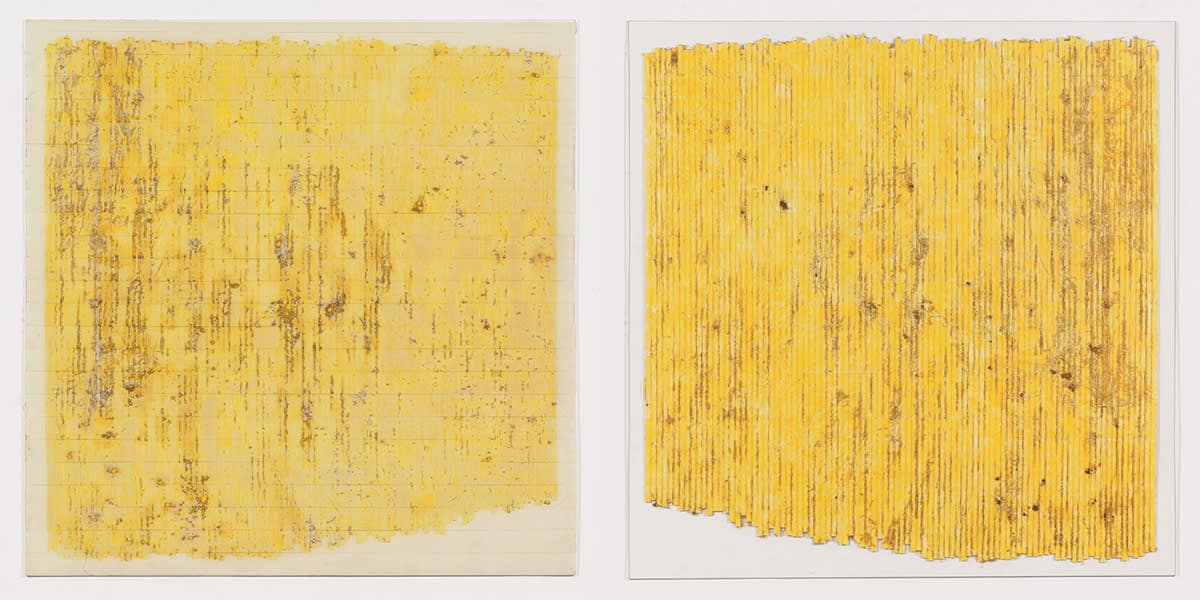
Merrill Wagner, Unbenannt A und B, 1978. Mit freundlicher Genehmigung des Künstlers und der Zürcher Gallery, New York.
Merrill Wagner bei Zürcher Galerie
Der Stand der Zürcher Galerie auf der Frieze war fast ein Abbild ihrer Ausstellung mit Merrill Wagners Werken im letzten Jahr. Der 1935 geborene Wagner erhält endlich Anerkennung als postminimalistischer materialistischer Maler.
Die meisten ihrer auf der Frieze gezeigten Arbeiten wurden in einem einzigartigen Verfahren mit Gewebeband und Plexiglas hergestellt, das Wagner in den 1970er Jahren entwickelte. Was ihre monochromen, minimalistischen Gemälde so ungewöhnlich macht, ist ihr Interesse an der Zersetzung und Lebensdauer von Pigmenten. Inspiriert von der langen Geschichte der Pigmente als Alchemie, greift Wagner auf die Darstellung von Farbe als erdiges Material zurück, das im Dienste des menschlichen Ausdrucks manipuliert und auf Oberflächen ausgebreitet wird. Einige der neu ausgestellten, mit Alizarin-Karminrot gefärbten Klebebandbilder stechen besonders durch ihre satten Farbtöne hervor. Die Vielfalt an Sättigung und Glätte auf der Oberfläche erweckte das Werk zum Leben. Wie ein Rothko schimmerte es, wenn du vor ihm hin und her gingst, wobei das unscheinbare Monochrom leuchtete und wieder verschwand.
Es war auch eine Freude, einige von Wagners Landschaftsinterventions-Fotodokumenten in einem Raster ausgestellt zu sehen. Wagner, die viel Zeit auf dem Land verbringt, hat eine Reihe von Werken geschaffen, die sie im Freien auf Zäunen in der umliegenden Landschaft gemalt hat. Während ihrer Lebenszeit fotografierte sie deren Verwesung an Ort und Stelle und beobachtete, wie Sonnenlicht und Wetter das Werk veränderten. Wagner beschleunigt die entropische Natur der Malerei und spricht sie gleichzeitig in der Landschaft an. Es gibt eine schöne Bucharbeit zu diesen Stücken, die einen umfassenderen Blick auf diese performativen Gemälde wirft.
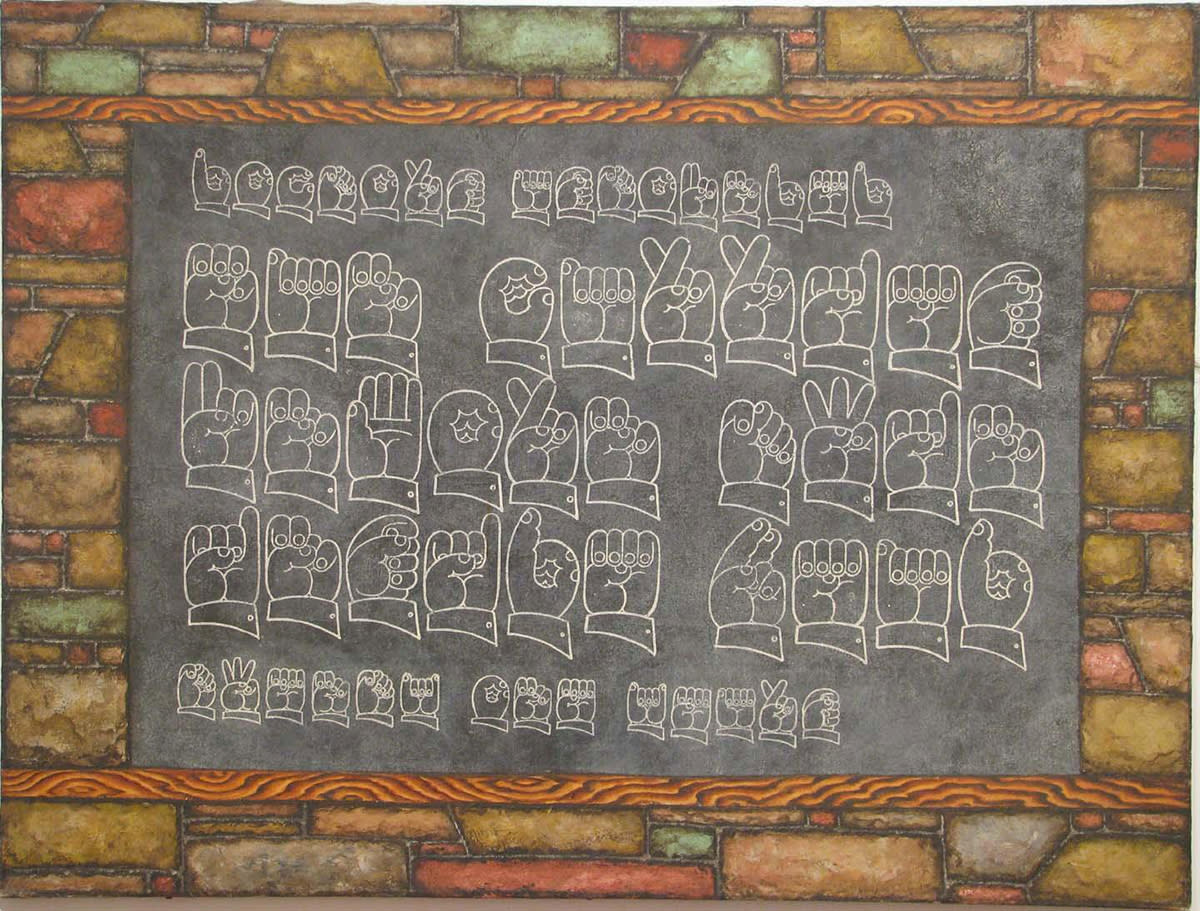
Martin Wong, Mann trägt ungeborenen Zwilling in seinem Kopf 21 Jahre lang mit sich herum, 1982. 36 x 48 cm. Acryl auf Leinwand. Mit freundlicher Genehmigung der P.P.O.W. Gallery.
Martin Wong und Peter Hujar im Hinterzimmer des P.P.O.W. Galerie
Diese beiden Künstler waren im Hinterzimmer von P.P.O.W. ausgestellt, einer Galerie mit einem tollen Programm. Ich mochte die Arbeiten, die im Hauptraum ausgestellt waren, aber ich fand es wirklich toll, im Hinterzimmer einige Perlen von Künstlern zu sehen, die ich bewundere und die ich nicht erwartet hatte. Das ist das Schöne an Kunstmessen: Es gibt immer ein Hauptereignis - den geplanten Stand -, aber das Schöne an Messen sind die versteckten Überraschungen. Die Gespräche zwischen Menschen, die durch die Hallen schlendern. Die Kunsthandwerker, die am Vortag die Stücke wie Geschenke auspacken. Das Hinterzimmer kann ein magischer Ort sein. Er kann Werke enthalten, die gerade in einem Künstleratelier oder Nachlass entdeckt wurden.
Am P.P.O.W.-Stand fand ich zwei Werke, die die Nachlässe von Martin Wong und Peter HujarHujar und Wong, die beide vor allem in den 1980er Jahren arbeiteten und Werke schufen, die sich mit der AIDS-Epidemie, figurativen Beziehungen und Identität auseinandersetzen. Hujar ist vor allem für seine introspektiven Schwarz-Weiß-Porträts bekannt, während Wong, ein chinesisch-amerikanischer Maler, mit sehr persönlichen und sich wiederholenden Motiven malt. Seine Werke gehören zu meinen Lieblingswerken, die ich kennengelernt habe, seit ich nach New York gezogen bin, und ich fand es toll, dass ich die Gelegenheit hatte, seine Arbeit noch einmal zu erkunden.
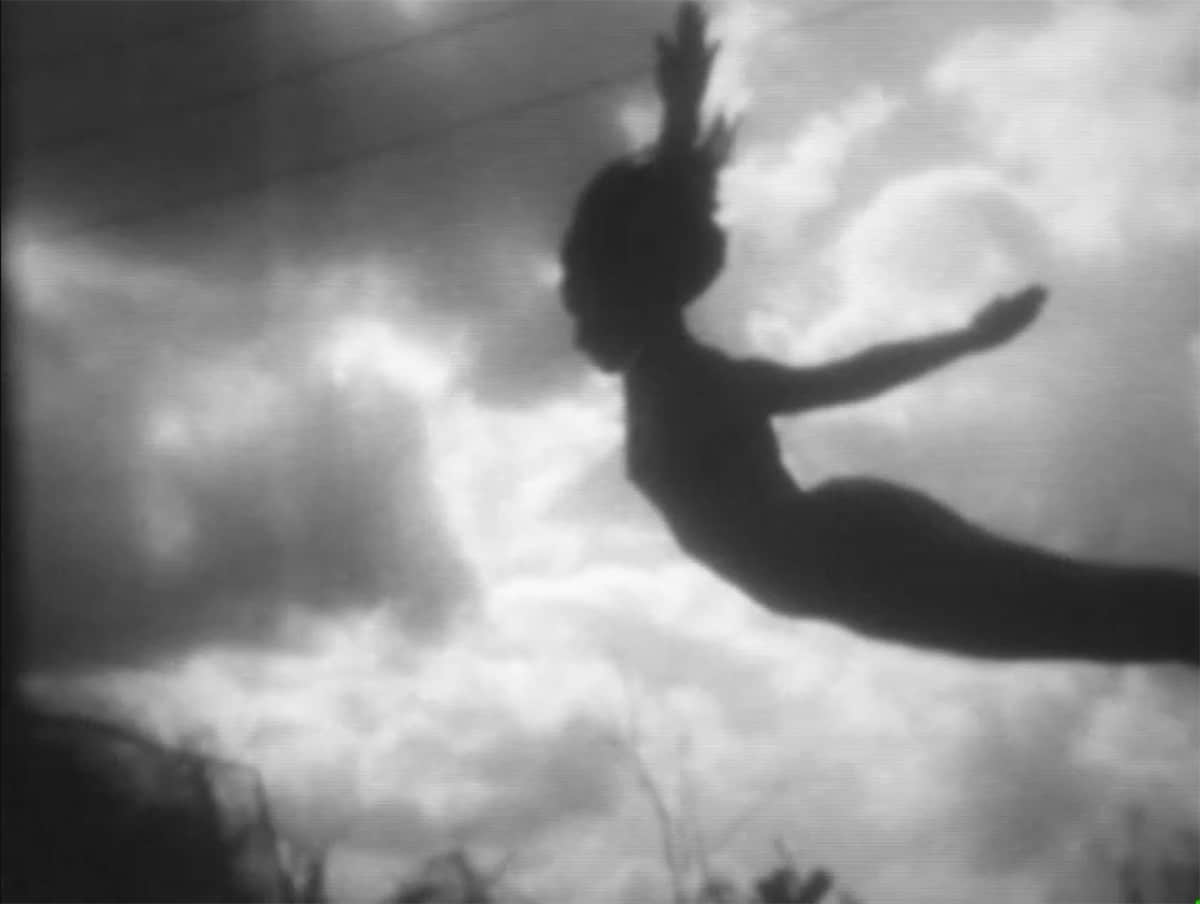
Hans Breder, Ikarus, 1974. Fotostandbild aus Ikarus. Mit freundlicher Genehmigung der Galerie Ethan Cohen.
Hans Breder bei Ethan Cohen Galerie
Obwohl ich die Standmöbel von Ethan Cohen als große Ablenkung empfand, gelang es mir, sie vor meinem inneren Auge zu verdrängen. So konnte ich mich auf die elegante, performative Arbeit des in Deutschland geborenen Künstlers Hans Breder konzentrieren, die einen provokanten Raum mit einfachen Objekten und Körpervorschlägen im filmischen und fotografischen Raum enthüllte. Breder, der letztes Jahr im Alter von 81 Jahren verstorben ist, verdient diese Aufmerksamkeit für sein Werk. Breders Arbeiten, die oft den Körper zum Thema haben, balancieren zwischen der Vorstellung von Erhabenheit und häuslicher Einfachheit. Es ist interessant zu sehen, wie sich diese beiden Seiten der Skala des Künstlers in seinen nüchternen, einfachen Bild- und Filmstrategien die Waage halten.
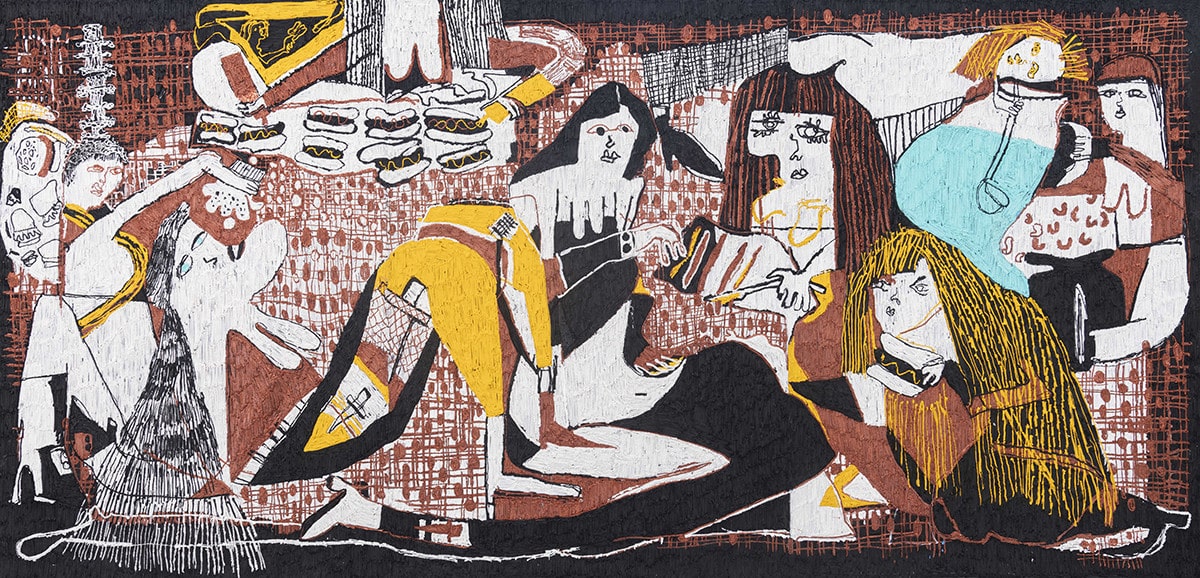
Summer Wheatley, Picknick mit Ketchup und Senf, 2018. 74 x 144 cm. Acryl auf Aluminiumgewebe. Mit freundlicher Genehmigung der Andrew Edlin Gallery.
Sommerweizen bei Andrew Edlin Galerie
Ich war schon immer ein Fan von Sommer Weizen's ätzenden, obsessiven Gemälden sah ich ihre Arbeit zum ersten Mal bei der Triangle Artist Residency 2010. Auf der Frieze habe ich diese neuen Gemälde zum ersten Mal auf einer Aluminiumleinwand gesehen. Aus der Ferne wirken sie wie üppige, skulpturale, glänzende Farbteppiche. Wheat hat diese neue Technik entwickelt: Sie arbeitet die Acrylfarbe auf der Rückseite des Schirms auf und schiebt sie dann auf die Vorderseite, um fadenartige Formen der Farbe zu simulieren. Da Wheat früher mit Öl gemalt hat, ist es nur logisch, dass sie jetzt für diese neue Anwendung schnell trocknendes Acryl verwendet. Der Prozess muss sowohl mühsam als auch befreiend sein. Er ist genau und ungenau zugleich.
Diese Werke sind voller Symbolik und Geschichten, die für die Geschichte der narrativen Tapisserie typisch sind. Die Motive erinnern an einige Bilder, die ich 2015 bei einem Atelierbesuch gesehen habe. Hier sehen wir Picknicks, Körper, Objekte, Keramiken, Muster, den Nachthimmel und die Landschaft. Die Werke erinnern mich an Schriftrollen oder verschlungene Panoramen. Ihre ausladende Länge, die immersive Qualität und die minimale Palette laden dazu ein, sich Zeit zu nehmen, um die Technik, die versteckten Bilder und den übertriebenen Sinn für Raum zu entschlüsseln. Ich bewundere Wheats Arbeit schon lange, und diese neuen Bilder scheinen ihre Interessen zwischen Handwerk, Farbe, Thema und Technik zu vereinen.
